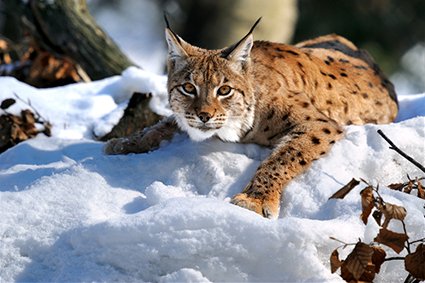20 Facts About Lynx
1. Lynx are one of the smaller big cats. They weigh between 22 and 44 pounds. They’re about 80-120cm long and 60cm tall at the shoulder. Their tail is another 10-20cm. If you were standing beside one, they’d be just above your knee. The perfect height for a pat on the head (if they were friendly).
2. A lynx is not very fast compared to other big cats. It can run up to 50 miles per hour. Think about driving beside a lynx going that fast. With such a small frame, it’s insane a lynx can reach such speeds.
3. Lynx are animals that stay solo for most of their lives. They will only come together to mate, or when the female lynx are raising the kittens. Other than that, they like to keep to themselves like a solo traveler.
4. Lynx have short, stubby bodies and furry, grey and tan coats. They have distinctive tufts on their ears that help them hear better. They have a short tail that looks as if it were docked. It could have evolved from being in such thick forested areas that a tail would just take up extra space.
5. Lynx live in cold areas, such as northern North America, Asia, and Europe. They like the cold because of their thick, fluffy coat. They have lots of fur on their paws that keeps them extra warm at their extremities.
6. Lynx have natural snowshoes. Their paws will spread out when they touch the ground to provide better weight distribution. Just like when you walk around on snowshoes to make your feet bigger, so you don’t fall through the snow and ice!
7. Lynx and bobcats are very similar. Many people think they’re the same animal, but they’re different. They’re in the same family (the Lynx genus), but are a slightly different species. The lynx has a black tail, but a bobcat has a bit of white on the bottom of theirs. Lynx also have longer ear tufts and bigger paws.
8. Lynx are great predators. They will attack anything they can feasibly take down. Since they don’t like to run after prey, they will sneak up and pounce at the right opportunity.
9. Lynx like to hunt at night. They have large eyes and ears to provide superior vision and hearing. They catch faster animals, such as hares, at night with their advanced abilities. While hares are also nocturnal, they can’t compete if they’re taken by surprise.
10. Lynx look like oversized housecats. Despite their advanced
abilities to kill prey, their appearance is quite cute and cuddly. Their beards make their faces look wide and circular, which increases their similarity to a housecat appearance.
11. Hares are by far the most common meal lynx go for. They will also go for birds and deer, but less so. Birds don’t have enough meat for the effort, and deer are too much effort for the possibility of a hoof in the face.
12. Lynx will live in caves, under cliffs ledges, in rock formations, under fallen trees, tree stumps, and thick bushes. They will cuddle up anywhere that seems safe and keep themselves and their babies warm.
13. Lynx will live up to 14 years in the wild, but up to 26 in captivity. This is because they have access to healthcare and protection from external factors. They can’t have their land taken, be poached, or go hungry. However, they don’t get to roam free and have to live in a cage in captivity.
14. Snowshoe hares and lynx are so tightly connected that when the hare population drops, so does the lynx population. Then, if the population goes back up, so does the lynx population. There are so few viable options for lynx they must heavily rely on the hares (90% of their diet). It’s such a clear-cut visual of a food chain.
15. Lynx can have a genetic mutation that turns them blue. People call them blue lynx, but it’s just a mutation. Other colors can range from reddish brown to regular grey. If you see a blue lynx in the wild, consider yourself lucky.
16. Canada’s lynx population has been tracked since the 1730s. This is because the Hudson’s Bay Company wanted to keep track of the lynx population to use their furs. Now, the tracking is continued to know how endangered the species is. Thanks, Hudson’s Bay.
17. A slightly larger subspecies of lynx has been found in Newfoundland. Shockingly, it has been named the Newfoundland Lynx. It is rare and has been known to bring down caribou, which are much larger than your average hare.
18. Breeding season is quite fleeting for lynx. It’s kind of like courting season in the 1800s. It only lasts from March to May. Further, females only make themselves available to get pregnant for three to five days of the year. Quite a short window for potential suitors.
19. A Canada Lynx was once shot and killed in the United Kingdom. It was being kept as a pet and escaped. The English were most likely very shocked to see a Canadian big cat running around their streets.
20. Lynx use their pee to mark their territory. This territory can have huge ranges. It can be 15 to 50 square kilometers, or up to 700 square kilometers in some cases. Guess it just depends on how strong their pee smells.











